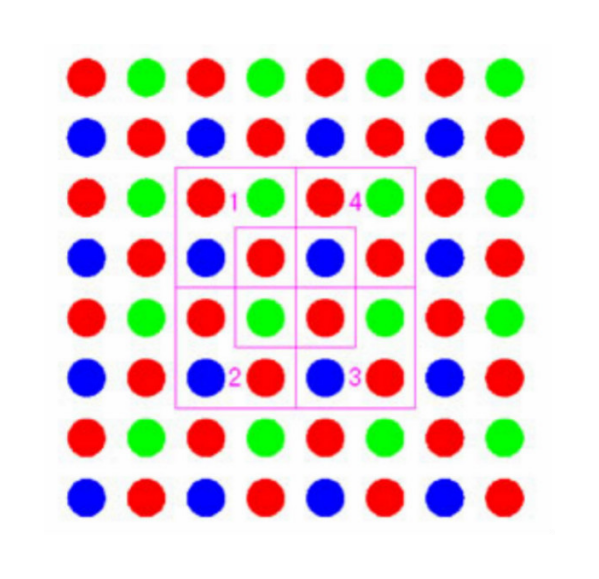When we choose COB display, we may see real pixel LED display and virtual pixel LED display. So what is real pixel? What is virtual pixel?
Real Pixel
Real pixel is the most basic and direct pixel technology in LED display screens. Its core is “one-to-one correspondence between physical pixels and display pixels.”
- 1. Definition and composition
Each real pixel is composed of a physical LED light group, typically containing red (R), green (G), and blue (B) LED lights (the three primary colors). Together, these three constitute an independent physical pixel unit. Physical pixels correspond 1:1 with display pixels. The display can only display a fixed amount of image information based on the number of pixels it actually has.
For example, a real pixel unit might be “1R1G1B” (1 red, 1 green, 1 blue light). Depending on brightness requirements, we might use a combination like “2R1G1B”. In this case, the number of physical pixels on a display equals the number of actual displayed pixels. If a screen has M physical pixels horizontally and N vertically, the total number of displayed pixels is MxN, and the resolution is MxN.
- 2. Characteristics, advantages and disadvantages
Advantages
- Realistic and detailed display: Each display pixel corresponds to a real physical pixel, without synthesis or virtual calculation. When viewed up close, details are clear, and the image is real and stable without blur.
- Accurate color reproduction: The three-primary color LED lights emit light directly, and natural color mixing, which is suitable for scenes with high requirements for color accuracy. Such as studios, monitoring centers, and conference rooms.
- Mature, reliable technology with good compatibility: The real pixel drive logic is relatively simple, with low requirements for the control system (receiving card, video processor), and the technology is very mature. Furthermore, it is perfectly compatible with almost all video sources and control systems, eliminating display anomalies caused by algorithm mismatches.
Disadvantages
- Higher cost: High resolution requires more physical pixels (that is, more LED lights). And hardware costs increase significantly as resolution increases.
- Limited application scenarios: Suitable for small dot pitch. If pursuing ultra large size and high resolution, real pixel technology may lead to high costs and difficult to popularize.
Virtual Pixel
Virtual pixels, also known as shared pixels or dynamic pixels. Utilize pixel arrangement optimization and drive technology to allow the sub-pixels (red, green, and blue) of adjacent physical pixels to work together, creating a larger number of “virtual display pixels” than physical pixels. This improves resolution without increasing the number of physical pixels. In other words, virtual pixels break the “one-to-one” relationship between physical pixels and display pixels.


- 1. Definition and Principle
The core of virtual pixels is “sub-pixel multiplexing”. Physical pixels are distributed according to a specific rule (such as staggered arrangement), and the red, green, and blue sub-pixels of adjacent physical pixels will be “shared” and combined into new virtual pixels. That is, each LED (RGB) can be shared with 2/3/4/6/8 pixels, which is 2/3/4/6/8 times.
For example, the sub-pixels of four physical pixels can collectively form four virtual pixels (total display pixels are twice the physical pixels), or nine physical pixels can form 16 virtual pixels (a 4x improvement). In this case, the number of displayed pixels = the number of physical pixels x the multiple (commonly 2x or 4x), significantly improving the equivalent resolution.
- 2. Characteristics, advantages and disadvantages
Advantages
- Smoother dynamic display effects: When playing high-speed motion video content, virtual pixels fill the gaps between physical pixels, making the picture transition more continuous and smooth, and the dynamic visual effects more fluid and realistic.
- Lower cost: With the same physical size, the resolution can be improved without increasing the number of LED lights, significantly reducing the hardware cost of high-resolution scenes.
- Good effect at a long distance: When the human eye is watching from a long distance, it cannot distinguish the synthesis logic of virtual pixels and will think that the picture is more delicate, which is suitable for outdoor large screens (such as squares and highway billboards).
- Improved pixel utilization: Virtual pixels allow each physical light point to function over a wider range, transforming “one person, one job” into “one specialist, multiple skills.” This greatly improves the utilization efficiency of hardware resources and achieves higher visual resolution at a lower physical resolution cost.
Disadvantages
- Graininess at close range: When viewed up close, the synthetic traces of virtual pixels are obvious. Such as blurring and blurred edges. And the details are not as good as real pixels.
- Color mixing depends on the algorithm: The color of virtual pixels is formed by the superposition of multiple sub pixels. If the algorithm is not good, it may cause color deviation.
- Risk of dynamic ghosting: When switching between images quickly,such as in esports games or high-speed surveillance. Slight ghosting may occur due to delays in algorithm analysis. This is more noticeable in dark scenes (such as at night).
